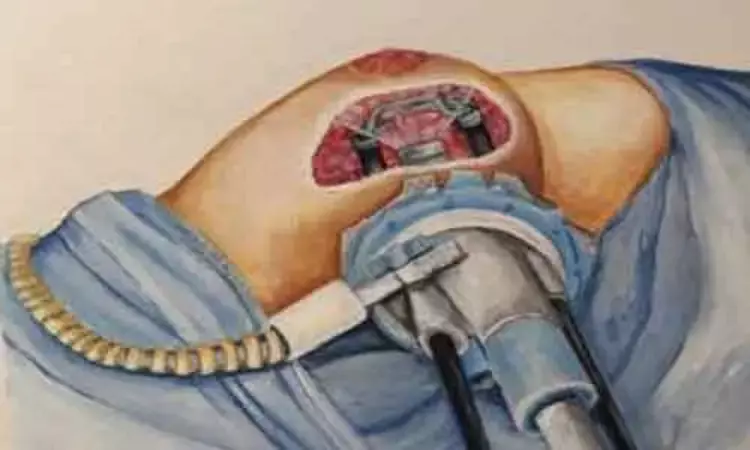- Home
- Medical news & Guidelines
- Anesthesiology
- Cardiology and CTVS
- Critical Care
- Dentistry
- Dermatology
- Diabetes and Endocrinology
- ENT
- Gastroenterology
- Medicine
- Nephrology
- Neurology
- Obstretics-Gynaecology
- Oncology
- Ophthalmology
- Orthopaedics
- Pediatrics-Neonatology
- Psychiatry
- Pulmonology
- Radiology
- Surgery
- Urology
- Laboratory Medicine
- Diet
- Nursing
- Paramedical
- Physiotherapy
- Health news
- Fact Check
- Bone Health Fact Check
- Brain Health Fact Check
- Cancer Related Fact Check
- Child Care Fact Check
- Dental and oral health fact check
- Diabetes and metabolic health fact check
- Diet and Nutrition Fact Check
- Eye and ENT Care Fact Check
- Fitness fact check
- Gut health fact check
- Heart health fact check
- Kidney health fact check
- Medical education fact check
- Men's health fact check
- Respiratory fact check
- Skin and hair care fact check
- Vaccine and Immunization fact check
- Women's health fact check
- AYUSH
- State News
- Andaman and Nicobar Islands
- Andhra Pradesh
- Arunachal Pradesh
- Assam
- Bihar
- Chandigarh
- Chattisgarh
- Dadra and Nagar Haveli
- Daman and Diu
- Delhi
- Goa
- Gujarat
- Haryana
- Himachal Pradesh
- Jammu & Kashmir
- Jharkhand
- Karnataka
- Kerala
- Ladakh
- Lakshadweep
- Madhya Pradesh
- Maharashtra
- Manipur
- Meghalaya
- Mizoram
- Nagaland
- Odisha
- Puducherry
- Punjab
- Rajasthan
- Sikkim
- Tamil Nadu
- Telangana
- Tripura
- Uttar Pradesh
- Uttrakhand
- West Bengal
- Medical Education
- Industry
Both conventional and minimal nipple-sparing mastectomy equally safe for breast cancer treatment: JAMA

A new study published in the Journal of American Medical Association found that the comparable complication rates of minimum access nipple-sparing mastectomy (M-NSM) and conventional nipple-sparing mastectomy (C-NSM) show that both techniques were equally safe.
Although formerly limited to open procedures, the frequency of nipple-sparing mastectomy (NSM) for breast cancer has been steadily rising with the use of endoscopic and robotic surgical equipment. Studies on postoperative problems and the advantages and disadvantages of minimum access NSM (M-NSM) in comparison to conventional NSM (C-NSM) are, nevertheless, scarce. Joo Heung Kim and colleagues carried out this investigation to look at the variations in postoperative complications between C-NSM and M-NSM.
In this retrospective multicenter cohort analysis, a total of 1583 female patients with breast cancer who were 19 years of age or older and had undergone NSM at 21 Korean university hospitals between January 2018 and December 2020 were enrolled. Patients with inflammatory breast cancer, breast cancer that had spread to the chest wall or skin, metastatic breast cancer, breast cancer with insufficient medical records, and mastectomy without preservation of the nipple-areolar complex (NAC) were excluded. The primary results and measures of this study were 3 months following surgery, postoperative complications, and clinicopathological variables were evaluated. The variables linked to problems were found by statistical studies, such as logistic regression.
A total of 227 people underwent M-NSM and 1356 people underwent C-NSM. Regarding the immediate and long-term postoperative problems, there was no discernible difference between the two groups. After C-NSM, the long-term prevalence of glandular-areolar complex necrosis was higher than that of M-NSM. Following M-NSM, wound infections happened more often. After C-NSM, the postoperative seroma was more common. Areolar or nipple necrosis was much more likely to occur in cases with mild or severe breast ptosis. In contrast, there was a decreased incidence of necrosis when axillary, anterior, or midaxillary incisions were used. When comparing direct-to-implant breast reconstruction to other breast reconstructions, necrosis happened far less frequently.
Overall, the frequency and extent of postoperative problems did not significantly differ between C-NSM and M-NSM, according to this study. Given their comparable rates of complications, C-NSM and M-NSM seem like about as safe of alternatives. As a result, the surgical strategy used should take the preferences and unique requirements of patients into consideration.
Reference:
Kim, J. H., Ryu, J. M., Bae, S. J., Ko, B. S., Choi, J. E., Kim, K. S., Cha, C., Choi, Y. J., Lee, H. Y., Nam, S. E., Kim, Z., Kang, Y.-J., Lee, M. H., Lee, J. E., Park, E., Shin, H. J., Kim, M. K., Choi, H. J., Kwon, S. U., … Kim, J. Y. (2024). Minimal Access vs Conventional Nipple-Sparing Mastectomy. In JAMA Surgery. American Medical Association (AMA). https://doi.org/10.1001/jamasurg.2024.2977
Neuroscience Masters graduate
Jacinthlyn Sylvia, a Neuroscience Master's graduate from Chennai has worked extensively in deciphering the neurobiology of cognition and motor control in aging. She also has spread-out exposure to Neurosurgery from her Bachelor’s. She is currently involved in active Neuro-Oncology research. She is an upcoming neuroscientist with a fiery passion for writing. Her news cover at Medical Dialogues feature recent discoveries and updates from the healthcare and biomedical research fields. She can be reached at editorial@medicaldialogues.in
Dr Kamal Kant Kohli-MBBS, DTCD- a chest specialist with more than 30 years of practice and a flair for writing clinical articles, Dr Kamal Kant Kohli joined Medical Dialogues as a Chief Editor of Medical News. Besides writing articles, as an editor, he proofreads and verifies all the medical content published on Medical Dialogues including those coming from journals, studies,medical conferences,guidelines etc. Email: drkohli@medicaldialogues.in. Contact no. 011-43720751


